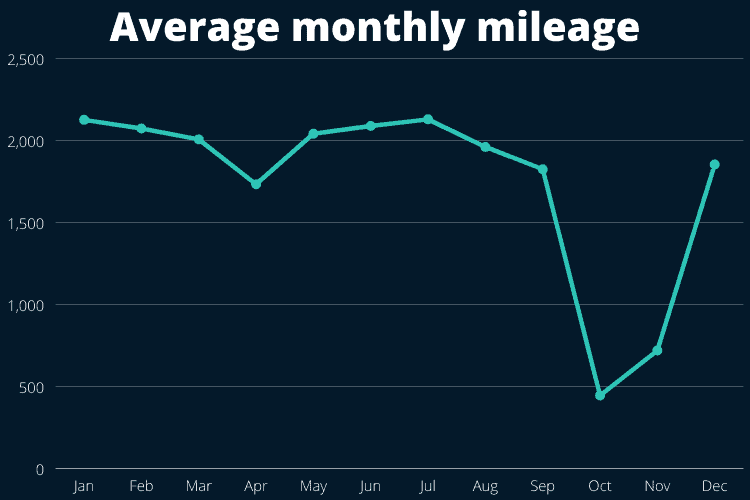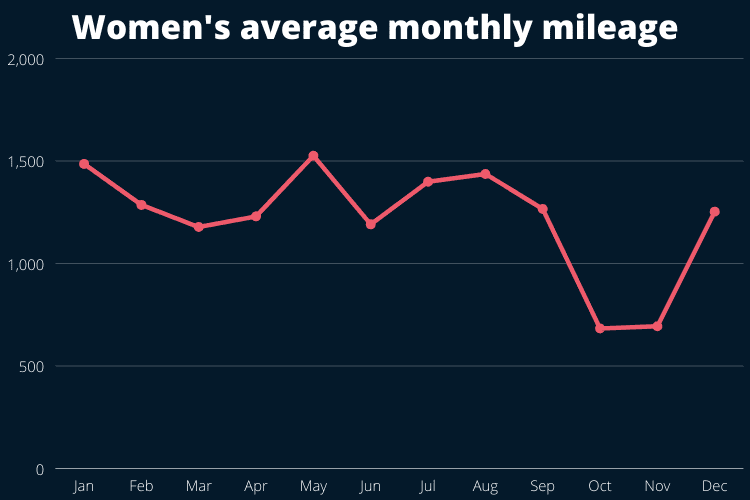Last season was my best one so far. I spent a lot of time on the bike, which resulted in record mileage. Then I started wondering how I compare to pro cyclists and how many miles they cover in a year. Let’s just say I’ll stick to writing.
A professional male cyclist averages 19,580 miles (31,511 km) per year, while a professional female cyclist annually covers 14,955 miles (24,068 km) on average. About 60% of that is done in training, and races contribute the rest. With women, the percentage is 80-20 in favor of training.
The accumulation of kilometers is by no means evenly distributed over the year. There are periods when cyclists ride a lot and periods when they hardly sit on the bike.
Average distances of male pros
Professional cycling is becoming more and more competitive, which means cyclists need to put more effort into preparation every year. The number of miles ridden per year rises slowly but steadily, and we can expect that 20,000 miles barrier will soon be broken.
Some cyclists have already done over 20,000 miles in a year, but the average is still under the magic number.
The average annual mileage of professional male cyclists is 19,580 miles (31,511 km). That is based on 40 professional riders’ stats from their Strava accounts. There are about 500 cyclists in the World Tour teams, so the sample represents about 8 percent of the population.
Miles are not evenly distributed throughout the year. In January, cyclists participate in team training camps, covering around 2000 miles per month. It’s the largest training block before the spring part of the season starts, where races become the primary source of the mileage.
After the spring, it’s time for stage races, which are usually the season’s main objective. Most annual mileage is covered in the weeks leading into the race and on the race itself.
On average, riders do 1,500-2,000 miles (2,500-3,500 km) per month, but the number drops to around 500 miles (800 km) during the off-season.

The season ends typically in September, and we can see a massive drop in mileage. For about two months, cyclists don’t touch their bikes or do just a few short rides. Towards the end of the year, they slowly start training again, but it’s not until mid-January that they really kick it off.
It’s interesting to look at the weekly average as well, as it fluctuates even more based on cyclists’ season objectives. Throughout the season, the weekly average fluctuates between 350-600 miles (600-1,000 km), but in the weeks before the race, it rises to 750 miles (1,200 km).

Average distances of female pros
Looking at professional female cyclists’ stats, I realized that I couldn’t compare to them either. While they are one step behind their male colleagues, they still achieve remarkable numbers.
On average, a professional female cyclist covers 14,955 miles (24,068 km) per year. Their races are much shorter than men’s, meaning that most of the mileage is gained in training. They do about 80 percent or 12,000 miles per year on training and only 20 percent or 3,000 miles on races.
Regarding race schedule, the women’s season is similar to the men’s. It starts in late February and runs until September. Their main event – Giro d’Italia Donne – is in July, right after the national championships. Because of them, June isn’t the most productive month in terms of mileage, as a lot of traveling is required and training isn’t possible.
Female cyclists average between 1,200 and 1,500 miles (2,000-2,500 km) per month. October and November are considered an off-season where mileage drops to around 700 miles (1,100 km). In December, the average mileage is back at a normal level.

Women’s weekly averages fluctuate less than men’s, mainly because they can regulate it better with a higher percentage of training. We can see a considerable drop-off in some weeks of October and November, but the weekly mileage is relatively consistent in other months.
On average, women cover 250-400 miles (400-600 km) per week. The number rises before the races, but not for more than a week. The maximum distance covered in a week is around 450 miles (700 km).

Traning vs. race distances
Finding a balance between training and races is one of the biggest challenges of pro cyclists. They need to be prepared for the races, but at the same time, be careful not to overtrain.
The biggest training blocks come before the season when there aren’t any races. Once the racing starts, the number of training drops significantly, especially with men. They have many more stage races, during which training is not possible.
Women’s stage races are much shorter than men’s. Their longest race lasts ten days, while the men have three races lasting 21 days in just one season. Therefore women cover a larger percentage of mileage at training compared to men.
Men cover 60 percent of their yearly mileage at training and around 40 percent on races. They do approximately 11,500 miles (18,500 km) on training and 8,000 miles (13,000 km) on races.
Women cover about 80 percent of their yearly mileage at training and only 20 percent at races. Most of their races are one-day events, while stages at multi-day races are typically relatively short. That changes every year, but no drastic changes are expected in the short term.
There is also a big difference in time spent on a bike. Men average 1,009 hours of riding per year, while women ride 766 hours per year on average.
There is only one female cyclist that can compare to men. A Dutch rider Annemiek van Vleuten checked in 1,120 hours of riding in 2021, covering 18,859 miles (30,352 km). That puts her in the third spot on a combined list of time spent on a bike and in the top 50 on the distance list.

